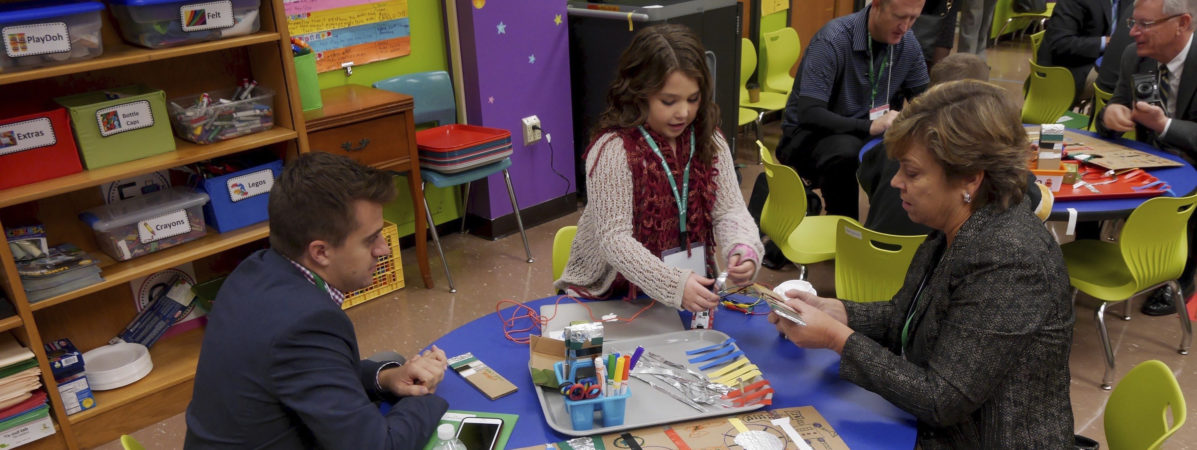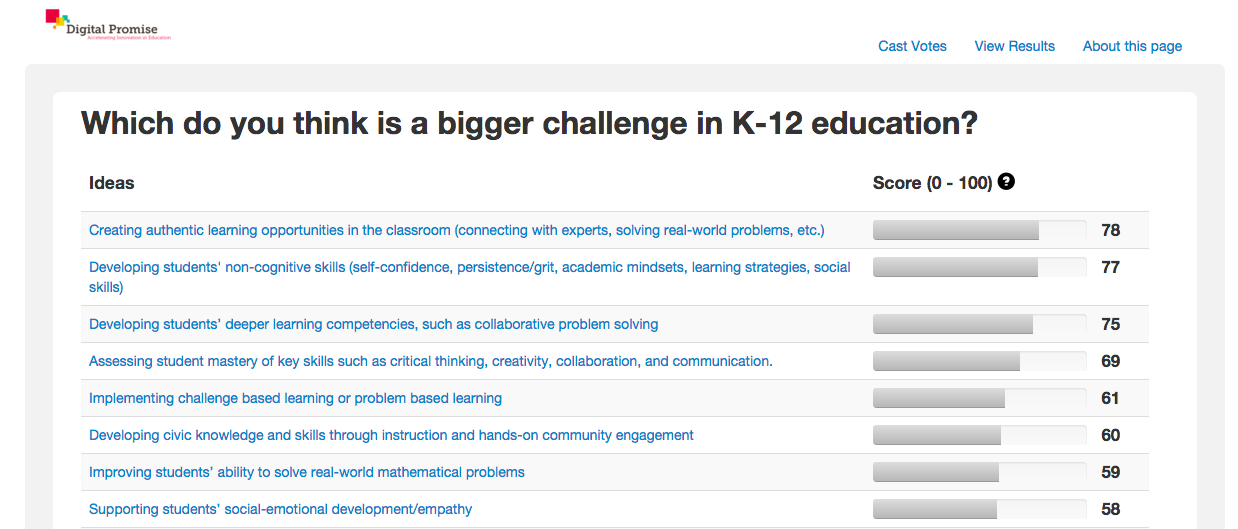
November 16, 2015 | By Aubrey Francisco
Across the country, schools are adopting new approaches to teaching and learning in order to prepare students for life in a technology-rich world. For example, South Fayette Township School District implemented computational thinking projects at every grade level, and Piedmont City School District uses competency-based learning so students can work at their own pace. Yet as schools break away from traditional models of education, new challenges emerge. We wanted to know: what do educators see as their top challenges? What kinds of solutions can be created to help?
To identify top challenges, we asked educators and education leaders to use a wiki survey crowdsourcing tool to answer the question: “Which is a bigger challenge in K-12 education?” Participants could vote multiple times for one of two possible answers (i.e. A or B?), and could also choose to submit their own ideas. The tool calculated a score for each possible answer, resulting in a prioritized list of challenges. A total of 276 people participated in the survey. Here are the top eight challenges that emerged from the responses:

Next, we combined responses that share similar elements. For example, we grouped together “creating authentic learning opportunities,” “challenge-based or problem-based learning,” and “developing civic knowledge through hands-on community engagement” because they all use hands-on, collaborative activities that are based on real-world conditions. We also combined non-cognitive skills with social-emotional development due to their shared focus on developing students’ personal and social skills. We were left with a list of the following top four challenges in K-12 education:
Collaboration among all education stakeholders, including researchers, entrepreneurs, community members, and educators, is needed to alter traditional teaching and learning processes and successfully meet these challenges. The following sections explain each challenge in greater depth, to provide all stakeholders with the background needed to find innovative solutions.
What is it?
We use the term authentic learning to describe approaches that encourage students to learn through hands-on, collaborative projects that address “real” problems relevant to their lives. Challenge-based, problem-based, project-based, and civic learning through community engagement are approaches that share a common interest in authentic learning.
Why is this important?
Students who participate in guided collaborative projects improve critical thinking and social skills needed for college and careers (P21, 2015). Further, authentic learning has the potential to make students more engaged. This is important, as students who are not engaged in learning are more likely to drop out of school (APA, 2012).
Why is this so challenging?
“The most challenging thing about implementing challenge-based learning in schools is changing the mindset of students and teachers,” says Dawn Hennessy, Technology, Design, Innovation and Robotics teacher at Carroll Magnet Middle School in North Carolina’s Wake County Public School System. She says students must learn the process for problem solving, which requires more time asking questions before jumping to solutions. On the other hand, teachers must empower students to be “completely in charge of how they learn the standards.”
Yet, Hennessy says support from administration has made it easier for her to implement a challenge based learning approach. “Once I realized that I had full support, and didn’t need to fear making mistakes, I felt completely safe to try it,” she adds.
What is it?
Non-cognitive skills are the behaviors, qualities, and skills that help students to be successful in school and life – and these are not connected directly to a subject or content area. According to researchers at the University of Chicago, non-cognitive skills include “academic behaviors, academic perseverance, academic mindsets, learning strategies, and social skills.” Mainstream media often describe specific student qualities or behaviors, such as “persistence, self-discipline, focus, confidence, teamwork, organization, seeking help, and staying on task” (U.S. News & World Report, 2015).
Social-emotional learning is a child’s ability to experience, manage, and express emotions; develop close relationships with others; and actively explore his or her environment and learn (American Academy of Pediatrics).
Why is this important?
University of Chicago researchers analyzed programs designed to improve students’ non-cognitive skills, and concluded that this training improves students’ academic performance and reduces racial/ethnic and gender performance gaps. Additionally, Durlak, Weissberg, Dymnicki, Taylor, & Schellinger (2011) found that participants in school-based social-emotional development programs improved their attitudes, behaviors, and academic performance.
Why is this so challenging?
Dawn Martesi, an instructional coach at Armstrong Middle School in Levittown, Pennsylvania, says supporting students’ non-cognitive development is challenging because it requires teachers to adopt a new mindset, different from the traditional view of teachers as content experts. To best support students’ non-cognitive skills, she says teachers must begin to see students as teachers, and “provide student-driven lessons that enable students to take the lead role in learning.”
Martesi says students on the school’s tech team build non-cognitive skills, including confidence and social skills, as they support both teachers and peers in implementing technology in the classroom. She explains, “We have a diverse group of learners, and this allows everyone on the team to collaborate and learn from one another.”
What is it?
Deeper learning encompasses the skills, understandings, and mindsets students need to succeed in college and career. This includes non-cognitive skills such as self-discipline and collaboration, as well as academic knowledge and critical thinking (Hewlett Foundation). Further, deeper learning develops students’ creativity and innovation, and information and technology literacy necessary to thrive in a digital world (P21).
Why is this important?
An American Institute for Research (AIR) study found that students enrolled in deeper learning programs improved their problem-solving skills, were more likely to graduate on time, and advanced more quickly in interpersonal and intrapersonal skills than students in other programs.
Deeper learning is also crucial for the health of our society and economy. Employers want employees who are able to communicate effectively and work in teams (NACE, 2015). Even more important: students will face extremely complex problems as they enter the workforce, such as rapid climate change and poverty. They will need to work collaboratively and apply knowledge in new ways to develop innovative solutions (Hewlett Foundation).
Why is this so challenging?
At Rancho Minerva Middle School in Vista Unified School District, Principal Ben Gaines says students use technology to develop deeper learning skills such as collaboration and communication as they connect with people across the globe. The most difficult part of implementing deeper learning, according to Gaines, is “moving teachers from the traditional setting to expanding their classrooms beyond what they are comfortable with. It takes time, strategy, and rethinking professional development.”
Similarly, Theresa Ewald, Assistant Superintendent of Kettle Moraine School District, says, “For some of our teachers, the strategies may be a very new way of thinking about learners and the classroom environment,” which requires them to take risks in their teaching. While this shift is difficult, Ewald adds, “It is a paradigm shift we continue to address, as we know real change and growth happens when mistakes and reflection lead us to answers.”
What is it?
Mathematical concepts and problem solving skills are essential for success in everyday life, including for understanding finances, politics, social relationships, and the arts (NCTM). In order to successfully solve real-world math problems, students need to apply basic math concepts to new challenges.
Why is this important?
The new Common Core standards for math, as well as other college and career-ready standards, require students to develop real-world math skills. Specifically, students develop conceptual understanding, or a deep understanding of how math “works,” and then learn to apply concepts when faced with new or different problems. Simply memorizing math equations and solutions is no longer sufficient.
The ability to apply math concepts to real-world situations is also essential for success in STEM (Science, Technology, Engineering and Math) careers. The U.S. Department of Education named STEM education a priority due to the high demand for graduates with these skills, and the importance of these skills for tackling challenging world problems. Many school districts across the country now provide STEM curricula at all grade levels.
Why is this so challenging?
Ayanna Ramsey, math teacher at Chute Middle School in Evanston-Skokie Community Consolidated School District #65, says it is difficult to fully adopt real-world math because it requires a “complete redesign of what learning looks like.” Teachers, schools and districts must take a huge risk to move outside the current structure based on set math textbooks and standardized tests. Also, it is time-consuming to recruit community partners for real-world projects. Despite these challenges, she and her colleagues regularly assign students real-world math projects such as researching college fees and tuition costs in order to learn about exponential growth.
To spur innovation and address education’s most pressing challenges, researchers, entrepreneurs, and community members must partner with educators to find solutions. In the coming months, we will launch new projects to directly address these four challenges, and want to highlight stories of others doing the same.
Educators: How are you tackling these challenges in your classrooms?
Developers: How could technology address these challenges?
Researchers: How can we measure progress in meeting these challenges?
Share your thoughts with us on Twitter: @digitalpromise
Let us know: how are you tackling the top challenges in K-12 #education? https://t.co/ylaQhFN3M1 pic.twitter.com/kybichaAQs
— Digital Promise (@DigitalPromise) November 19, 2015
By Jeremy Roschelle, John Whitmer and Peter Bull
By Adrianna S. and Kyrie F.